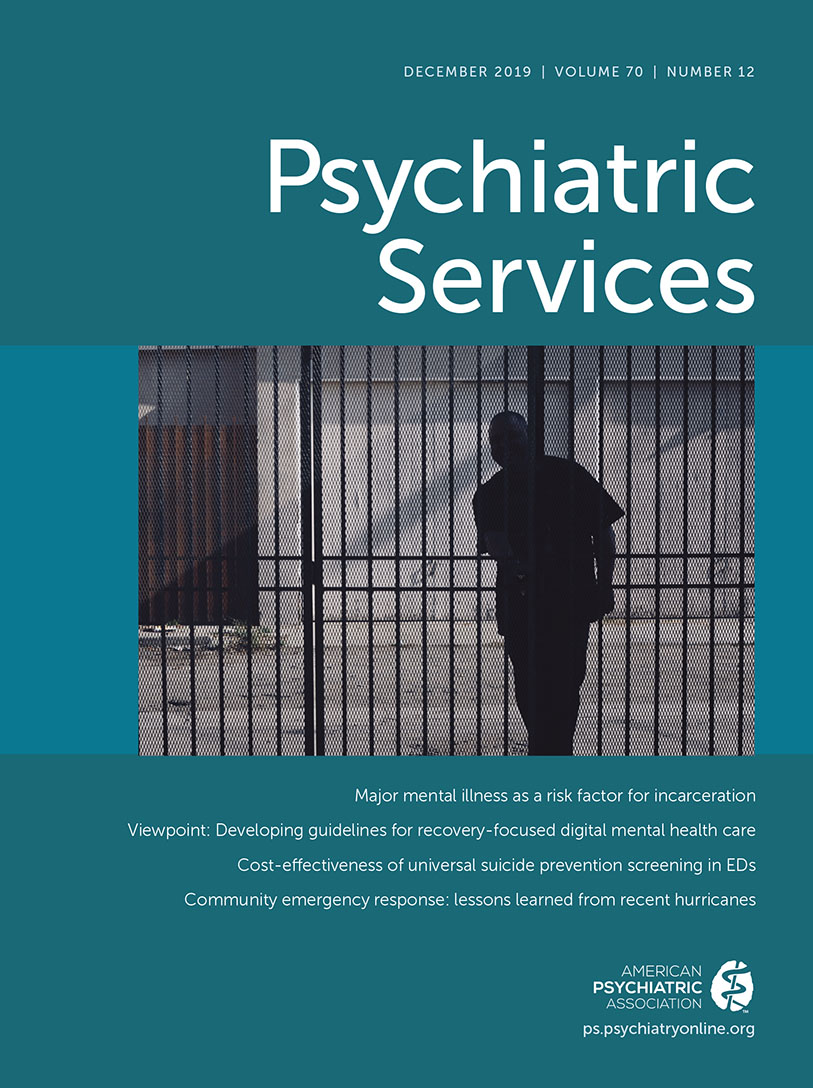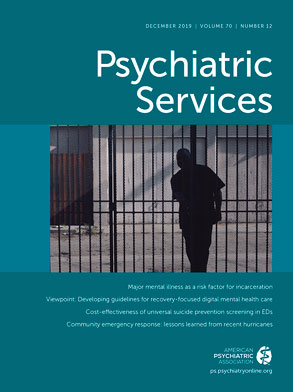The number of people with opioid use disorder in the United States has increased substantially over the past 20 years, fueled in part by a dramatic increase in opioid prescriptions (
1). According to the National Epidemiologic Survey on Alcohol and Related Conditions–III (NESARC-III), in 2012–2013, 4.4% of men and 3.9% of women age 18 or older used these medications for nonmedical purposes (
2). Furthermore, lifetime prevalence of heroin use jumped from 0.3% of Americans age 18 or older in 2001–2002 to 1.8% in 2012–2013 (
3). Nonmedical opioid use varies dramatically by region and is more common among men, young people, Caucasians, and those with lower education and lower income. Unfortunately, most individuals with an opioid use disorder have not engaged in treatment (
2).
One of the most devastating consequences of opioid abuse is accidental overdose. Overdose deaths related to opioids have risen dramatically over the past 16 years, reaching almost 50,000 deaths in 2017—a figure that does not include overdose deaths with unspecified drugs, some of which may have been attributable to opioids. Consequently, the U.S. Department of Health and Human Services has declared the problem an epidemic (
4), and Congress has passed the SUPPORT for Patients and Communities Act, which was signed into law in 2018 (
5), authorizing almost $8 billion to address the crisis. As federal and state governments plan to respond, psychiatry must play a leading role in addressing the problem of opioid use disorders in U.S. communities (
6).
Psychiatrists are experts in understanding the pathophysiology, psychosocial contributors, impact, and treatment of central nervous system disorders, including opioid use disorder. Given this expertise and the high rates of opioid use disorder among patients with other mental health conditions, psychiatrists face an exciting opportunity to embrace and incorporate into their practices person-centered, integrated treatment of people with opioid use disorder and to advocate for improved policies that support the treatment of opioid use disorder in our communities. In this Open Forum, we outline ways that community psychiatrists can participate in solutions to this epidemic as clinicians, administrators, and advocates in the community.
How Can Psychiatrists Participate in the Office?
Screening and detection.
Because substance use disorders commonly co-occur with other disorders (i.e., mood, anxiety, and personality disorders) and are a risk factor for suicide, psychiatrists in all settings must screen for substance misuse in addition to mental illnesses. In the NESARC-III, lifetime opioid use disorder was associated with higher rates of posttraumatic stress disorder in men and women, mood disorders in men, and other anxiety disorders in women (
2). Furthermore, severe mental illnesses and opioid use disorder commonly co-occur (
7). For optimal detection and treatment of opioid use disorder, addiction psychiatrists in specialty settings can address the disorder and co-occurring mental illnesses. Psychiatrists in other settings can increase screening and detection of opioid use disorder for patients with mental illness by asking all patients—at intake and regular intervals thereafter—about substance use and problems related to use by using tools such as the National Institute on Drug Abuse’s NIDA-Modified ASSIST. Information from other sources (e.g., families), including biological tests (e.g., urine drug screens), may also be helpful. Failure to address opioid use disorder in patients with depression, anxiety, and other disorders will likely result in poor outcomes and patient dissatisfaction with the care they receive.
Treatment decision making.
After diagnosing an opioid use disorder, psychiatrists can work with patients to identify treatment goals, which may include reducing or abstaining from risky substance use. Using shared decision making, psychiatrists can help patients select among treatments that are best matched to their preferences and treatment goals and can then either treat patients or refer them to the appropriate care. Psychiatrists may either assist in transitioning a patient to providers with expertise treating opioid use disorder, comanage patients along with opioid use disorder specialists, or manage the opioid use disorder pharmacotherapy and other treatments themselves. Given the urgent need to increase treatment capacity in the United States, all psychiatrists should develop skills to diagnose and offer basic treatment for opioid use disorder and should be able to coordinate with other providers to care for patients with acute or complex needs.
Cases of opioid use disorder range from straightforward to complex. After a comprehensive assessment, psychiatrists can ensure that behavioral and psychosocial treatments are provided to address co-occurring addiction and mental illnesses as well as housing, employment, and social support needs. In addition to collaborating with colleagues, outcomes can be improved by incorporating family, peers, and community members into team-based treatment. Finally, it is important to instill hope and reduce stigma by using person-centered and recovery-oriented language with patients and care providers.
Pharmacotherapy.
Pharmacotherapy for opioid use disorder is safe, effective, and critically important for improving outcomes and preventing accidental overdose. Methadone, an agonist with a half-life of about 1 day in tolerant individuals, can be dispensed only in federally licensed programs. In contrast, buprenorphine can be prescribed in an office-based practice. An opioid partial agonist with a half-life of 1–2 days for people who have recently used opioids, buprenorphine is delivered either sublingually with naloxone (i.e., Suboxone) to prevent injection abuse or in long-acting injections and subcutaneous delivery devices. To prescribe buprenorphine, physicians can undergo 8 hours of training and obtain a waiver certification. As of 2012, 2.2% of U.S. clinicians had obtained waivers; among those with waivers, 41.6% were psychiatrists and 36.7% were primary care providers (
8). Availability of buprenorphine providers varies greatly, with fewer providers in rural areas and the Midwest, but is generally low in relation to the size of the population in need (
9). Naltrexone, an opioid antagonist, is available in daily oral and extended-release depot forms for people who have completed withdrawal. This medication may have lower acceptability but is an important option, especially for people with mild disorders and for those who have not responded to other approaches. Additionally, benzodiazepines, which contribute to risk for accidental overdose, should be avoided. Finally, a prescription for naloxone, an effective antidote to opioid overdose, can allow family and friends of the patient to administer the medication in case of accidental opioid overdose.
Addressing structural, workflow, and provider needs.
Expanded use of office-based pharmacotherapy to treat people with opioid use disorder could dramatically increase access to treatment and enhance treatment quality. To facilitate psychiatry’s expanded involvement in office-based treatment of opioid use disorder, several factors require attention: intervention and practice workflow, provider beliefs and willingness to work with the patient group, and environmental characteristics, such as reimbursement policies.
Addressing structural and systems issues for each of the evidence-based pharmacotherapy options to treat opioid use disorder can facilitate treatment delivery. First, psychiatrists using these medications must develop the systems to track prescriptions and provide records to federal auditors (for buprenorphine prescriptions). Second, psychiatrists must have on-site capacity to confirm substance use, abstinence, and withdrawal symptoms. To receive buprenorphine, patients who use opioids must be in a confirmed state of withdrawal and must be monitored during repeated dosing over the first few hours on the first treatment day. A system whereby nurses offer in-office monitoring can be developed. Alternatively, home-based induction is becoming more common (
10). To receive naltrexone, patients must be opioid free for 7–10 days prior to taking the medication in order to avoid precipitating withdrawal. Third, providing extended-release naltrexone via an intramuscular injection requires either a system and licensure for refrigerated storage or relationships with pharmacies that store and deliver this medication. Some providers require that patients pick up their medications and bring them to the office on the day of medication delivery. Fourth, during pharmacotherapy for opioid use disorder, prescribers must monitor periodic urine drug screens to track ongoing illicit drug use, guide dosing adjustments and psychosocial treatments, and confirm medication use to reduce diversion. Fifth, psychiatric providers must have the capacity to provide or refer patients to behavioral and psychosocial interventions, which many patients need to maintain abstinence and advance their recovery. Finally, insurance coverage and cost of these interventions must be addressed.
Clinicians are more comfortable providing treatment when they have adequate knowledge and office workflows that support and inform the treatment. The Substance Abuse and Mental Health Services Administration now supports access to free Web-based and in-person training and ongoing peer supervision through programs such as the Providers Clinical Support System (
https://pcssnow.org). In clinics with multiple clinicians, experts can help administrators create supportive workflows—including standard processes for buprenorphine inductions, urine drug screens, documentation, and peer consultations—for all clinicians. In larger systems, clinician interventions, such as academic detailing, can enhance knowledge and improve prescribing. In coordinated, “stepped” care, such as the hub-and-spoke model tested in Vermont (
11), providers deliver treatment at a particular level of intensity and refer patients to other providers for care at different levels of intensity. This model can enable specialty care during intensive treatment phases followed by a “step down” to local treatment by nonspecialists. Thus, relationships with colleagues and facilities that can care for patients with severe disorders can ease any concerns clinicians with less experience may have about providing care. Finally, if there is to be a shift in the culture of psychiatry, it is time to ensure that, at a minimum, all psychiatrists-in-training receive buprenorphine training.
How Can Psychiatrists Participate in the Community?
Federal, state, and local policies, such as covering treatment of substance use disorder in Medicaid programs and explicitly encouraging providers to prescribe, can support increases in use of buprenorphine and naltrexone (
12). Medicaid expansion in 33 states increased insurance coverage for buprenorphine, leading to increased prescribing in those states (
13). Nevertheless, some providers believe reimbursement rates are still insufficient (
14). Additionally, many patients with addiction are not able to afford self-pay for care. For pharmacotherapy to be available to all who need it, psychiatrists should advocate with state policy makers to include opioid use disorder treatment within insurance plans at adequate reimbursement rates and should contract with insurance plans to provide this care.
In communities that lack adequate numbers of waivered providers and specialty clinics, psychiatrists should work with community organizations, such as laboratories, hospitals, and clinician groups, to develop referral bases and service partnerships, to obtain training and technical assistance for service development, and to raise community support for treatment of people with opioid use disorder. Given the significant influx of new funding, psychiatrists should work with local and state governments to develop thoughtful plans for implementing services in partnership with federal organizations rolling out the SUPPORT for Patients and Communities Act. Plans are needed to address state regulations to facilitate service delivery, expand local insurance coverage for opioid use disorder services, and ensure that state licensing boards facilitate evidence-based practices with minimal administrative burdens.
In some states, separate funding streams support addiction and mental health treatment, reinforcing separate care systems that are difficult for patients and clinicians to navigate. Other states have integrated this funding, reducing barriers to person-centered, integrated care. In states without integration, psychiatrists should advocate for the integration of funding streams and state administration and for improvements in policies and insurance coverage in order to increase capacity for and quality of integrated, comprehensive care for people with co-occurring opioid use and mental disorders.
Conclusions
For over 30 years, psychiatry has been concerned with the challenge of expanding and integrating treatment for people with co-occurring substance use and mental disorders (
15). The availability of effective office-based pharmacotherapy, the deaths due to high-potency illicit opioids, and the public attention to this matter have created an opportunity to expand psychiatry’s role in the treatment of people with addiction. Given psychiatrists’ responsibility for treating people with all mental disorders, including substance use disorders, now is the time for our field to engage more broadly in providing care to this group and to speak with a unified voice on their behalf.

